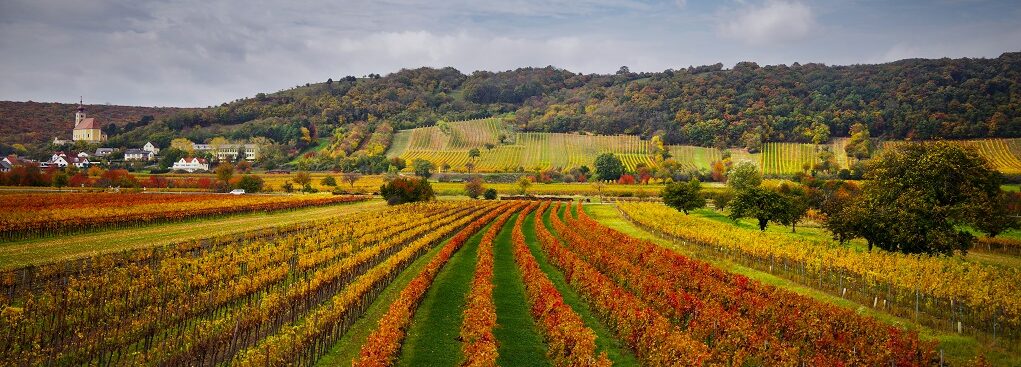Beautiful isn't it, when autumn turns the wine leaves red. The picture shows the Leithaberg in the region of Burgenland, near Hungary. Burgenland produces red wines brimming with flavour under the influence of the warm, continental Pannonian climate. Pick some with the help of our wine tips.
TEXT MARJOLEIN SCHUMAN | IMAGE AUSTRIAN WINE
Austrian wine regions | Episode 3: Burgenland
There is something magical about this area. Do we remember it from our geography lessons? The Pannonian Plain or Carpathian Basin is a large plain in central/southeastern Europe that was created when the Pannonian Sea dried up in the Pliocene. The Great Plain forms the core of the area, but it continues into Burgenland, where it provides fertile soil and plenty of sunshine to grow grapes. Burgenland is Austria's easternmost state, which was still part of Hungary until 1921.
Especially the grape Blaufränkisch
Burgenland produces the country's most opulent and authoritative red wines. Eighty per cent are reds. Mostly from Blaufränkisch, a typical Austrian grape variety. But there are also complex white wines and exceptionally fine sweet wines. Neusiedlersee noble sweet wines, made from grapes affected by botrytis (noble rot), are world-famous. Thanks to the progressive approach of winemakers, wines from international grape varieties and powerful red cuvée blends have also gained recognition in recent years. Take a quick look at our wine tips below to taste the wines!
5 wine tips for all tastes
- Franz Weninger is among the best in Austria. By the way, half of his 50 hectares are in Hungary, on loamy soil with iron-rich clay. His biodynamic Blaufränkisch has 12 months of wood aging, powerful flavours of ripened fruit and a long finish.
- WENINGER BLAUFRÄNKISCH 2020 MITTELBURGENLAND DAC | ANFORS-IMPERIAL.COM | €16.25
- Nobody is averse to innovation, as long as it can be done in a sustainable way. This also applies to the Bayer family of one of the oldest wineries (1741!). Their Chardonnay is spicy and fresh with the necessary minerality from the soil and creaminess from the wood ageing.
- WEINGUT BAYER-ERBHOF, CHARDONNAY LEITHABERG DAC | | GERMANWTOPWIJNEN.NL | €15.95
- From the grape Blauer Zweigelt, a cross between St Laurent and the above-lauded Blaufränkisch, Marcus Iro in Neusiedlersee makes terroir wines that are among the best in Austria. This one is juicy, full of forest fruit and spice, with a very favourable price!
- WEINGUT MARKUS IRO ZWEIGELT NEUSIEDLERSEE 2021 | WINE TRADEMOREAU.NL | €10.95
- Johannes Gabriel in the small town of Rust relies on nature and the experiences of his forefathers. His amber-coloured Trockenbeerenauslese smells of exotic and dried fruits and you taste honey notes with some spice and a fine balance of sweet and sour.
- GABRIEL RUSTER AUSBRUCH DAC CHARDONNAY | FRIENDSOFEASTRIJKSEWIJN.NL | €25
- Special, this dessert wine by Alois Kracher from 100 per cent merlot from various vineyards from Neusiedlersee. With fresh cherries and plums on the nose and peach, cherries and strawberries on the palate. Minerality in the finish provides a delicious mouthfeel.
- BURGENLAND SPÄTLESE 'ROSÉ' 2021 KRACHER | ANFORS-IMPERIAL.COM | €18.75
Subdivisions
Burgenland has a total area of 11,772 hectares. Following the introduction of the first regionally typical wine, Mittelburgenland DAC in 2005, other regions have also gained DAC status: Leithaberg DAC, Eisenberg DAC and Neusiedlersee DAC. The former Großlage of Rosalia became an independent DAC in 2018 as did the Ruster Ausbruch in 2020, finally completing Burgenland's DAC family.
Coarse loamy soils
Way down south, the Eisenberg offers perhaps Austria's best terroir for Blaufränkisch. The name comes from the iron-rich soils. The result? Wines with the finest minerality and incomparable elegance. The coarse loamy soils of Mittelburgenland and the Rosalia region give Blaufränkisch a special depth of fruit plus length on the palate, while in the hilly areas west of Lake Neusiedlsee this is enhanced with mineral notes and tannins.

Sweet, sweeter, sweetest!
Ruster Ausbruch is a world-renowned, tiny Austrian region for noble sweet wines from the area around the town of Rust. In 2020, it became the first sweet wine in Austria to be awarded a DAC. Liquid gold has been produced here since the 17th century. Spatlese is sweet, Beerenauslese is sweeter and Trockenbeerenauslese is sweetest.
So many terroirs, so many grapes
With its limestone and slate soils, the eastern slope of the Leitha Mountains offers a perfect terroir for complex white wines, especially for Pinot Blanc and Chardonnay, but also for Grüner Veltliner. East of the Neusiedlersee dominates Blauer Zweigelt, a grape that produces powerful, juicy red wines. Blaufränkisch and Sankt Laurent also achieve excellent results.
Austrian wine tasting
A total of 44,728 hectares are planted with grapes but what Austria makes in wine is top quality, chefs, wine critics and consumers around the world agree. To taste the country, WINELIFE brings bottles from different regions into your home. The big three first: Lower Austria along the Danube (27,074 hectares), Burgenland for its top red wines (11,772 hectares) and Styria with its fresh Sauvignon Blanc (5,086 hectares).
Want to know even more about the different wine regions? Read all on AUSTRIANWINE.COM
Don't want to miss a single edition? Subscribe then subscribe to WINELIFE Magazine now!
Want to stay up to date with the best articles? Follow WINELIFE Magazine on Instagram, Facebook and sign up for our fortnightly newsletter.




